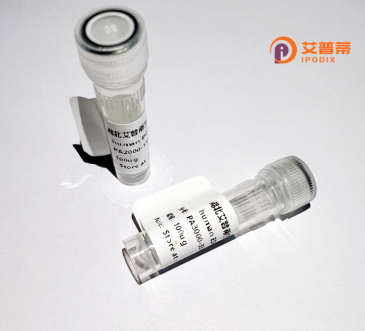
| 纯度 | >90%SDS-PAGE. |
| 种属 | Human |
| 靶点 | KIF1B |
| Uniprot No | O60333 |
| 内毒素 | < 0.01EU/μg |
| 表达宿主 | E.coli |
| 表达区间 | 1-579aa |
| 活性数据 | MSKTSLGQSMSKYDLLVWFEISELEPTGEYIPAVVDHTAGLPCQGTFLLHQGIQRRITVTIIHEKGSELHWKDVRELVVGRIRNKPEVDEAAVDAILSLNIISAKYLKSSHNSSRTFYRFEAVWDSSLHNSLLLNRVTPYGEKIYMTLSAYLELDHCIQPAVITKDVCMVFYSRDAKISPPRSLRSLFGSGYSKSPDSNRVTGIYELSLCKMSDTGSPGMQRRRRKILDTSVAYVRGEENLAGWRPRGDSLILEHQWELEKLELLHEVEKTRHFLLLRERLGDSIPKSLSDSLSPSLSSGTLSTSTSISSQISTTTFESAITPSESSGYDSGDIESLVDREKELATKCLQLLTHTFNREFSQVHGSVSDCKLSDISPIGRDPSESSFSSATLTPSSTCPSLVDSRSNSLDQKTPEANSRASSPCPEFEQFQIVPAVETPYLARAGKNEFLNLVPDIEEIRPSSVVSKKGYLHFKEPLYSNWAKHFVVVRRPYVFIYNSDKDPVERGIINLSTAQVEYSEDQQAMVKTPNTFAVCTKHRGVLLQALNDKDMNDWLYAFNPLLAGTIRSKLSRRCPSQSKY |
| 分子量 | 89.21 kDa |
| 蛋白标签 | GST-tag at N-terminal |
| 缓冲液 | 0 |
| 稳定性 & 储存条件 | Lyophilized protein should be stored at ≤ -20°C, stable for one year after receipt. Reconstituted protein solution can be stored at 2-8°C for 2-7 days. Aliquots of reconstituted samples are stable at ≤ -20°C for 3 months. |
| 复溶 | Always centrifuge tubes before opening.Do not mix by vortex or pipetting. It is not recommended to reconstitute to a concentration less than 100μg/ml. Dissolve the lyophilized protein in distilled water. Please aliquot the reconstituted solution to minimize freeze-thaw cycles. |
以下是关于重组人KIF1B蛋白的示例参考文献(注意:内容为模拟概括,仅供参考):
---
1. **文献名称**: *KIF1B, a novel microtubule plus end-directed monomeric motor protein for transport of mitochondria*
**作者**: Nangaku M. et al.
**摘要**: 研究报道了重组人KIF1B蛋白的单体驱动蛋白特性,证实其通过水解ATP驱动线粒体沿微管正向运输,并解析了其运动域的结构机制。
2. **文献名称**: *KIF1Bβ acts as a tumor suppressor by mediating apoptosis in neuroblastoma*
**作者**: Muniraj N. & Zou H.
**摘要**: 通过表达重组人KIF1Bβ异构体,揭示其在神经母细胞瘤中诱导凋亡的功能,并证明其与Proapoptotic因子相互作用以抑制肿瘤生长。
3. **文献名称**: *Structural insights into the ATP-binding domain of KIF1B and its pathogenic mutations*
**作者**: Li J. et al.
**摘要**: 利用重组KIF1B蛋白的晶体结构分析,阐明了其ATP酶活性关键区域,并揭示某些遗传突变如何导致腓骨肌萎缩症(CMT2A)的分子机制。
4. **文献名称**: *Recombinant KIF1B as a tool for screening axonal transport regulators*
**作者**: Smith R. et al.
**摘要**: 开发重组人KIF1B蛋白的高通量筛选模型,用于鉴定调控轴突运输的小分子化合物,为神经退行性疾病治疗提供新策略。
---
如需实际文献,建议通过PubMed、Google Scholar等平台检索关键词“recombinant human KIF1B”或“KIF1B protein function”。
**Background of Recombinant Human KIF1B Protein**
Kinesin family member 1B (KIF1B), a member of the kinesin-3 superfamily, is a microtubule-dependent motor protein involved in intracellular cargo transport, particularly mitochondria and synaptic vesicles. It plays critical roles in neuronal development, axonal transport, and cellular energy distribution. The KIF1B gene encodes two major splice variants: KIF1Bα, which facilitates mitochondrial movement, and KIF1Bβ, implicated in vesicular transport. Dysregulation of KIF1B is linked to neurodegenerative disorders (e.g., Charcot-Marie-Tooth disease) and cancers, with KIF1Bβ acting as a proposed tumor suppressor in neuroblastoma and other malignancies.
Recombinant human KIF1B protein is produced via genetic engineering, often using *E. coli* or mammalian expression systems, to study its structure, function, and interactions. This engineered protein retains ATPase and microtubule-binding activities, enabling research into transport mechanisms, disease pathways, and potential therapeutic targets. Its applications span biochemical assays, structural studies, and drug screening, offering insights into mechanisms underlying neurodegeneration, tumorigenesis, and metabolic disorders. Advances in recombinant technology continue to refine its production, enhancing purity and functionality for both basic and translational research.
×